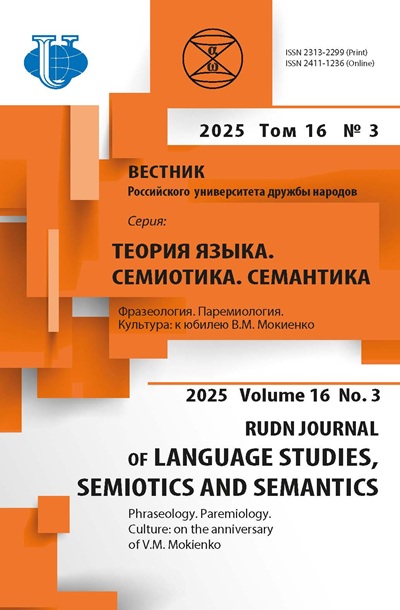ЯЗЫКОВЫЕ ЕДИНИЦЫ С САКРАЛЬНОЙ СЕМАНТИКОЙ: ЛИНГВОКУЛЬТУРОЛОГИЧЕСКИЙ И ЛЕКСИКОГРАФИЧЕСКИЙ АСПЕКТЫ
- Авторы: Шкуран О.В.1
-
Учреждения:
- Луганский национальный университет им. Тараса Шевченко
- Выпуск: Том 10, № 2 (2019)
- Страницы: 336-352
- Раздел: ФРАЗЕОРЕСУРСЫ
- URL: https://journals.rudn.ru/semiotics-semantics/article/view/21753
- DOI: https://doi.org/10.22363/2313-2299-2019-10-2-336-352
- ID: 21753
Цитировать
Полный текст
Аннотация
Паремии являются прецедентными языковыми единицами, которые относятся к области речевой стихии. Наличие сакральных компонентов в составе этих единиц, переосмысленных в соответствии с речевой ситуацией, свидетельствует о высокой мотивации внутренней формы коммуникативной микроструктуры. В нашей статье мы называем их языковыми единицами с сакральной семантикой и даем такое определение - это сложно структурированное морализующее высказывание с целостными и обобщенными представлениями о позитивном отношении народной культуры к традиционной религии. Исследуемые паремии имеют параллельные компоненты, размещенные в линейной последовательности. Важной чертой для паремиологической семантики являются «слабые мысли», т.е. их сложно понять, не зная ситуации, которую они полностью характеризуют. Для поговорок немаловажным является дискурсивная интенция, которая иллюстрирует когнитивное содержание с нравственной, а в нашем случае - с традиционно конфессиональной функцией. Современные социальные, идеологические, нравственно-этические и бытовые проблемы соотносятся и соизмеряются с бытием сакрального мира, чтобы нынешним проблемам придать одновременно вселенский и временной характер, оценивая их с точки зрения догматов традиционной религии. В статье на диахроническом социо-историко-культурном фоне проиллюстрированы этнолингвомаркеры горе, беда, сила, ум в составе устойчивых языковых единиц с сакральной семантикой Горе - не беда; Сила есть - ума не надо ; представлены основные периоды общепринятого употребления вышеназванных компонентов в лексикографических источниках и репрезентована сакрализация данных смыслов в русской православной культуре. Однако в процессе цивилизационных изменений мы констатируем профанизацию сакральных смыслов до уровня иронического. Данные паремии - языковые с сакральной семантикой - одновременно и фразеосочетание, и афористическое высказывание, и микротекст с глубоким лингвокультурологическим содержанием, отражающим разные исторические, идеологические, политические эпохи. Процесс обмирщвления языковых единиц с сакральной семантикой можно объяснить и открытой формой самих паремий, предполагающих различные формы трансформаций. При помощи активного паремиеупотребления народ вырабатывает особые принципы отношения к миру, к Богу, к человеку и делает это на своем родном языке и во многом с помощью языка, что и открывает нам возможности для исследования новых языковых субпарадигм.
Ключевые слова
Об авторах
Оксана Владимировна Шкуран
Луганский национальный университет им. Тараса Шевченко
Автор, ответственный за переписку.
Email: oksana.shkuran@mail.ru
кандидат филологических наук, доцент кафедры украинской филологии и издательского дела Луганского национального университета имени Тараса Шевченко
Ул. Оборонная, 2, Луганск, Украина, 91016Список литературы
- Алефиренко Н.Ф. Проблемы фразеологического значения и смысла (в аспекте межуровневого взаимодействия): монография. Астрахань: Издательский дом «Астраханский университет», 2004.
- Бредис М.А. Определения пословицы в отечественной лингвистике // Вестник Центра международного образования Московского государственного университета. Филология. Культурология. Педагогика. Методика. 2015. № 4. С. 12-17.
- Баранов А.Н. Аспекты теории фразеологии. М.: Знак, 2008.
- Буслаев Ф.И. Древнерусская литература и православное искусство. СПб.: Лига Плюс, 2001.
- Беринда П. «Лексіконъ славенорωсскїй и именъ Тлъкованїє» / Підг. тексту і вступ. ст. В.В. Німчука. К., 1961. URL: http://litopys.org.ua/berlex/be.htm/ (дата обращения: 01.01.2019).
- Владимирова Т.Е. Русская филология и духовный потенциал языка: материалы XIVIII Международной научно-практической конференции «Русское культурное пространство: коммуникативные аспекты». М.: МГУ ИРЯиК имени Ломоносова, 2018. С. 128-132.
- Даль В.И. Толковый словарь живаго великорускаго языка: материал из Википедии - свободной энциклопедии: Версия 7042034, сохран. в 20:19 UTC 17 января 2008 / Авторы Википедии // Википедия, свободная энциклопедия. Сан-Франциско: Фонд Викимедиа, 2008. URL: http://ru.wikipedia.org/oldid=7042034 (дата обращения: 02.01.2019).
- Ильченко В.И., Шелюто В.М. Духовная культура в пространстве сакрального: монография. СПб.: Изд-во «Ъ», Луганск: Пресс-экспресс, 2016.
- Карабулатова И.С. Языковая личность в пространстве межкультурных коммуникаций // Вестник Кемеровск. гос. ун-та искусств и культуры. 2011. № 16. С. 77-85.
- Коновалова Н.И. Сакральный текст как лингвокультурный феномен: монография. Екатеринбург: ГОУ ВПО «Уральский гос. пед. ун-т», 2007.
- Ломакина О.В. Фразеология в тексте: функционирование и идиостиль: монография / под ред. д-ра филол. наук, проф. В.М. Мокиенко. М.: Изд-во РУДН, 2018.
- Маслова В.А. Лингвокультурология. М.: Издательский центр «Академия», 2001.
- Миронова Т.Л. Русская душа и нерусская власть. М.: Изд-во «Алгоритм», 2013.
- Мокиенко В.М. Загадки русской фразеологии. СПб.: Авалон, Азбука-классика, 2005.
- Национальный корпус русского языка. URL: http://ruscorpora.ru/ (дата обращения: 02.01.2019).
- Пермяков Г.Л. Основы структурной паремиологии. М.: Наука, 1988.
- Полное собрание русских летописей. Т. II. Ипатьевская летопись. М., 2001.
- Словарь української мови: зібрала редакція журнала «Кіевская Старина»: упорядкував, з додатком власного матеріялу Борис Грінченко. Київ, 1907-1909. I-IV т.
- Срезневский И.И. Материалы для словаря древне-русского языка по письменнымъ памятникамъ: изданiе отдъленiя русскаго языка и словесности Императорской Академiи Наукъ. Санктъ Петербургъ: Типографiя Императорской Академiи Наукъ, 1912. III т. и дополненiя.
- Словарь церковнославянского и русского языка, составленный Вторым Отделением Императорской Академии Наук. СПб., 1847. Т. 4.
- Словарь древнего славянского языка, составленный по Остромирову Евангелию / под ред. Ф. Миклошичу, Ф.Х. Востокову, Я.И. Бередникову и И.С. Кочетову. СПб., 1899.
- Солодуб Ю.П. Национальная специфика и универсальные свойства фразеологии как объект лингвистического исследования // Филологические науки. 1990. № 6. С. 55-65.
- Толковый словарь русского языка: в 4 т. / под ред. Д.Н. Ушакова. М.: Гос. ин-т «Сов. энцикл.»; ОГИЗ; Гос. изд-во иностр. и нац. слов, 1935-1940.
- Фасмер М. Этимологический словарь русcкого языка: в 4 т. М.: Прогресс, 1986. Т. 1: А-Д.
- Фролов О.В. О прошлом и настоящем. М.: Эдитус, 2015.
- Халанский М.Г. Великорусские былины Киевского цикла. Варшава: в тип. М. Зенкевича, 1885.
- Хайдеггер М. Время и бытие: статьи и выступления / сост., пер. с нем. и комм. В.В. Бибихина. М.: Республика, 1993.
- Шишков А.С. Славянорусский корнеслов. Язык наш - древо жизни на земле и отец наречий иных. СПб.: Издатель Л.С. Яковлева, 2005.
- ЭСБЕ (1890-1907): Энциклопедический словарь Брокгауза и Ефрона. Лейпциг, СПб. URL: http://ruscorpora.ru/ (дата обращения: 02.01.2019).
- ЭССЯ - Этимологический словарь славянских языков: праславян. лекс. фонд / Ин-т рус. яз. им. ВВ. Виноградова. М.: Наука, 1974. Вып. 31.
Дополнительные файлы












